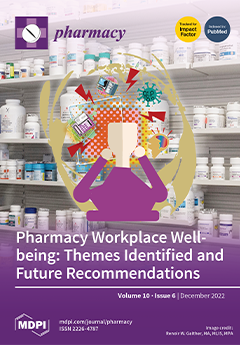Background: Pharmacists can offer medication expertise to help better control diabetes and cardiovascular disease (CVD) and improve patient outcomes, particularly in rural communities. This project evaluated the impact of an awareness campaign on perceptions of expanded pharmacy services.
Methods: The “Your
[...] Read more.
Background: Pharmacists can offer medication expertise to help better control diabetes and cardiovascular disease (CVD) and improve patient outcomes, particularly in rural communities. This project evaluated the impact of an awareness campaign on perceptions of expanded pharmacy services.
Methods: The “Your Pharmacists Knows” campaign included a 30-s commercial, print material, and media announcements. A non-randomized pre-post study was completed using a modified theory of planned behavior (mTPB) to assess knowledge, attitude, perceived benefits and norms, and perceived control. A 73-item survey was administered to a convenience sample (
n = 172) across South Dakota. Regression models to assess intent and utilization were conducted using age, gender, race, education, population, and insurance status as predictors for mTPB constructs.
Results: Most common predictors were female gender and higher education level (
p < 0.001). All mTPB constructs were significant predictors of intent to use services (
p < 0.001). Knowledge and perceived control had the largest influence on intent. Additionally, there was significant improvement in post-campaign service utilization (
p < 0.001).
Conclusions: This campaign positively influenced intent to seek and utilize services in rural communities where pharmacies may be the only healthcare option for miles. Through targeted campaigns, patients with diabetes or CVD may find access to services to better manage their conditions.
Full article





